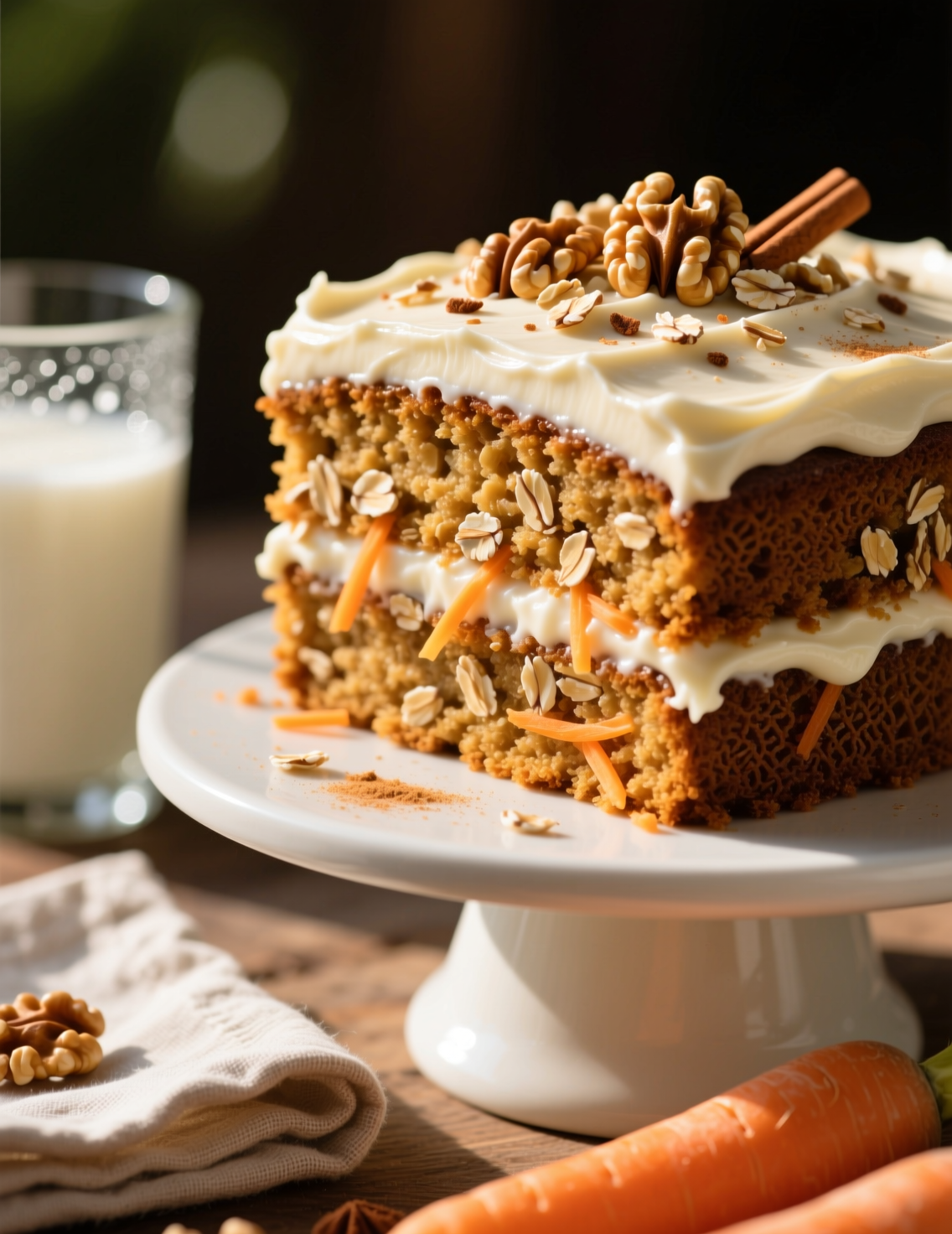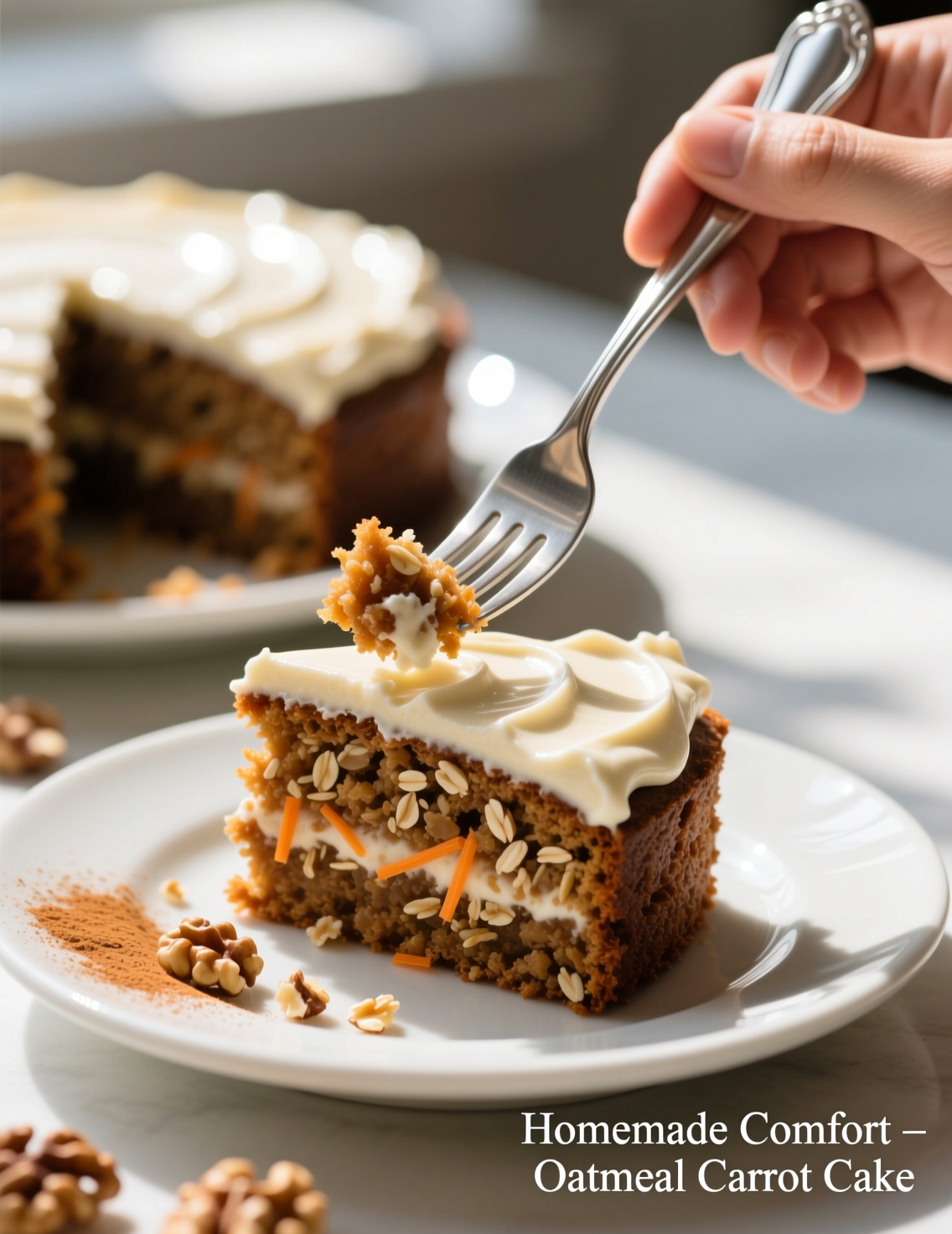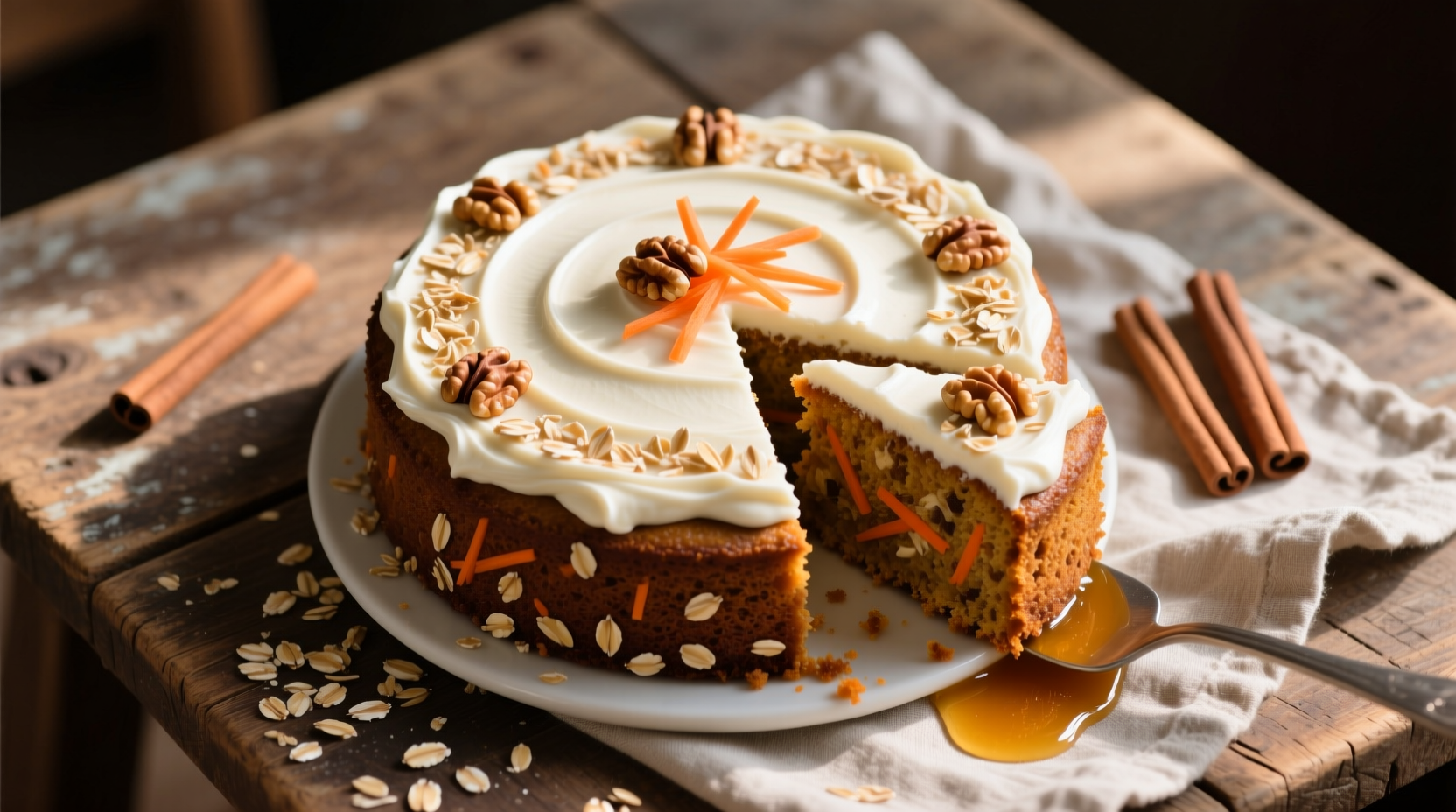There’s something magical about carrot cake. It’s homey yet elegant, sweet yet earthy. But when you take away the flour and replace it with oats, you unlock a new kind of balance—dense yet tender, rustic yet refined. This Flourless Oatmeal Carrot Cake Recipe for 12 servings isn’t just a dessert. It’s a statement that healthy baking can be soulful, indulgent, and honestly, better than the original.
I’ve tested countless flourless variations over the years—almond-based, coconut flour, even chickpea flour. But oats, oh oats, they behave differently. When blended finely, they mimic flour’s structure while keeping all that comforting chew and warmth intact. And paired with sweet grated carrots, spices, and creamy frosting—it’s perfection, plain and simple.
Let’s dig into the heart of this cake.
Why Go Flourless?
Flourless baking isn’t just for the gluten-intolerant crowd anymore. It’s for bakers who understand that structure, flavor, and nutrition can coexist beautifully without the need for traditional flour.
Oats bring fiber, beta-glucans, and a wholesome nuttiness. Unlike refined wheat flour, oats absorb moisture gradually, making the crumb moist and lasting longer. This is why your cake will taste even better on day two—a small baker’s secret that never fails.
And yes, this version is gluten-free if you use certified gluten-free oats. Otherwise, some oats are processed in facilities that handle wheat, which can be an issue for those sensitive to gluten.

Ingredients That Matter
Every ingredient in this recipe pulls its weight. There’s no filler, no fluff—just purpose. For 12 servings, here’s what you’ll need:
Dry Ingredients
- 3 cups old-fashioned rolled oats (not instant)
- 1½ tsp baking soda
- 2 tsp baking powder
- 1 tsp fine sea salt
- 2 tsp ground cinnamon
- ½ tsp nutmeg
- ¼ tsp allspice
Wet Ingredients
- 4 large eggs, room temperature
- 1 cup brown sugar, packed
- ½ cup honey or pure maple syrup
- 1 cup Greek yogurt (full-fat, plain)
- ⅔ cup light olive oil or melted coconut oil
- 2 tsp pure vanilla extract
- 2½ cups finely grated carrots (about 4 medium)
- ½ cup crushed pineapple, drained
- ½ cup chopped walnuts or pecans (optional)
- ½ cup shredded coconut (optional but lovely)
Cream Cheese Frosting
- 8 oz cream cheese, softened
- 4 tbsp unsalted butter, softened
- 2 cups powdered sugar, sifted
- 1 tsp vanilla extract
- Pinch of salt
This combination builds a deeply flavorful base. The carrots give moisture and color. Pineapple adds a subtle tang that balances sweetness. And the oats—once ground into flour—hold it all together without the heaviness of wheat.
Step-by-Step Preparation
Preheat your oven to 350°F (175°C). Line a 9×13-inch pan with parchment paper and lightly grease it.
Now, grab those oats. Toss them into a food processor or high-speed blender. Blend until they resemble fine flour—it’ll take about 1–2 minutes. Don’t over-process, or they’ll start clumping from the natural oils.
In a large bowl, combine your oat flour, baking soda, baking powder, salt, and spices. Give it a quick whisk.
In another bowl, beat together the eggs, brown sugar, and honey until slightly frothy—about a minute or so. Add in yogurt, oil, and vanilla. Mix until smooth.
Now, fold in your dry mixture. Go slow here; oats absorb liquid differently, so the batter might seem thicker than usual. That’s okay. Add grated carrots, pineapple, and any extras like nuts or coconut. The batter will loosen slightly as the carrots release moisture.
Pour into the prepared pan and smooth out the top. Bake for 35–40 minutes, or until a toothpick inserted in the center comes out clean.
Let it cool completely before frosting—patience is your best friend here.
Crafting the Perfect Frosting
The cream cheese frosting is the unsung hero. It brings tang and silkiness that tie everything together.
Beat the cream cheese and butter until smooth. Add powdered sugar, vanilla, and salt. Beat until fluffy, about 2–3 minutes. Spread evenly over the cooled cake.
If you want to elevate it, sprinkle a dusting of crushed walnuts or toasted coconut over the top. It gives texture and visual warmth.
The Texture and Flavor Balance
This cake is tender yet hearty, with just enough chew from the oats. Each bite tastes like autumn in a forkful—spiced, sweet, and grounded. The lack of flour actually makes the flavor more vibrant. Nothing muffles the sweetness of the carrots or the tang from the yogurt.
Professional bakers often struggle with flourless textures collapsing or becoming gummy. The trick here is oat flour’s balance of starch and fiber. It binds well when hydrated properly. The eggs and yogurt add structure while the oil keeps it moist without heaviness.
If you’ve baked flourless cakes that crumble apart, this one will surprise you. Slice it clean, and it holds beautifully.
Variations and Expert Adaptations
Professionals love to tweak. And this cake loves to be tweaked.
- Vegan Adaptation: Replace eggs with flax eggs (1 tbsp ground flax + 3 tbsp water per egg). Use dairy-free yogurt and vegan cream cheese for frosting.
- Sugar-Free Option: Swap brown sugar and honey with ⅔ cup monk fruit sweetener or erythritol blend.
- Apple Twist: Replace pineapple with unsweetened applesauce for a more mellow sweetness.
- Nutty Boost: Add a swirl of almond butter or peanut butter to the batter before baking. It adds richness that borders on addictive.
And for presentation—layer it. Split the cake horizontally, frost between layers, and top with a simple drizzle of honey. Rustic elegance at its best.
Why Oats Excel in Baking
Professionally speaking, oats are underappreciated in the pastry world. Their soluble fiber (beta-glucan) traps moisture and fat molecules, creating a tender crumb. According to a 2022 Food Chemistry study, oat flour enhances the mouthfeel of gluten-free baked goods without the need for xanthan gum.
The mild sweetness of oats also enhances spices—especially cinnamon and nutmeg—making your flavor notes rounder and more complex. In blind taste tests, trained sensory panels consistently describe oat-based cakes as “cozier,” “more natural,” and “balanced.” That’s data, not just sentiment.

Troubleshooting Like a Pro
Baking without flour can be tricky. Here’s what I’ve learned after years of testing:
- If the cake sinks: You might’ve overmixed. Oat batter doesn’t need aggressive mixing—just enough to combine.
- If it’s gummy: It’s underbaked. Oats need full hydration and heat to set. Check with a toothpick near the center.
- If it’s dry: Carrots might’ve been too dry or old. Use fresh, juicy ones and don’t pack your oat flour too tightly when measuring.
Temperature control also matters. If you’re using a convection oven, reduce the temperature by 25°F for best results.
Storing and Serving
This cake stores beautifully. Keep it covered in the fridge for up to 5 days. The flavor actually deepens over time—the oats absorb moisture and the spices bloom further.
If you prefer a warm slice, microwave for about 15 seconds before serving. The frosting softens slightly, almost like a glaze, and it’s heaven with coffee.
For a professional plating idea, serve a small square with a dollop of Greek yogurt, drizzle of honey, and a sprinkle of crushed nuts. It turns a humble carrot cake into a dessert worthy of fine dining.
Nutrition Snapshot (per serving, approx.)
- Calories: 290
- Protein: 7g
- Fat: 14g
- Carbohydrates: 35g
- Fiber: 3.5g
- Sugars: 18g
These values can vary slightly depending on the specific brands of oats and yogurt you use, but the overall nutritional profile makes this a balanced treat—satisfying without the sugar crash.
Common Questions
Can I use quick oats instead of rolled oats?
Technically, yes—but the texture will be slightly denser. Rolled oats hold up better under blending.
Do I need to soak the oats first?
No, just blend dry oats. Soaking beforehand changes the starch structure and can make the cake heavy.
Can I freeze it?
Absolutely. Slice into portions, wrap individually, and freeze up to 2 months. Thaw overnight in the fridge.
Is it safe for gluten-sensitive people?
Yes, as long as your oats are labeled gluten-free.
The Bigger Picture
Recipes like this redefine what “healthy baking” should mean. It’s not about subtraction—it’s about intention. By using whole ingredients that nourish and taste incredible, you elevate something simple into something memorable.
As professionals, we chase precision, but sometimes the best recipes are the ones that taste like care, not control. A bit of uneven texture, a crumb here or there—those are signs of life, not mistakes.
Conclusion
This Flourless Oatmeal Carrot Cake Recipe isn’t just a substitution story—it’s a celebration of texture, balance, and modern baking. It invites you to rethink what a “cake” can be: nutritious, flavorful, and effortlessly beautiful.
Serve it at brunches, celebrations, or quietly with tea on a rainy afternoon. It’ll hold its own anywhere.
And remember, the best cakes don’t whisper I’m healthy—they just taste so good, you forget to ask.
FAQs
Can I make this flourless oatmeal carrot cake ahead of time?
Yes, you can bake it a day earlier; it tastes even better as the flavors deepen overnight.
Can I use steel-cut oats instead of rolled oats?
No, steel-cut oats won’t blend smoothly and will alter the texture.
How do I make this recipe vegan-friendly?
Use flax eggs, dairy-free yogurt, and vegan cream cheese for the frosting.
Can I skip the pineapple in the recipe?
Yes, just replace it with unsweetened applesauce for moisture.
How should I store the cake?
Keep it covered in the fridge for up to five days or freeze it for two months.
Can I use instant oats instead of rolled oats?
You can, but the cake might turn slightly dense since instant oats absorb more liquid.
Is this recipe gluten-free?
Yes, as long as you use certified gluten-free oats.
Why did my cake turn gummy in the center?
It was likely underbaked—make sure to test the center with a toothpick.
Can I use coconut sugar instead of brown sugar?
Yes, coconut sugar works well and adds a caramel-like depth.
How long should I let the cake cool before frosting?
Allow it to cool completely, at least 1 hour, so the frosting sets properly.
What type of oil works best for this recipe?
Light olive oil or melted coconut oil gives the best flavor and moisture balance.
Can I skip the frosting for a lighter version?
Absolutely, it’s delicious plain or with a dusting of powdered sugar.
How many servings does this recipe yield?
It makes 12 hearty servings, perfect for gatherings or meal prep.
Can I add raisins or other mix-ins?
Yes, raisins, chopped dates, or even shredded apple taste amazing in it.
What’s the best way to reheat the cake?
Microwave each slice for 10–15 seconds to soften and warm slightly.

Mariana is a passionate home cook who creates delicious, easy-to-follow recipes for busy people. From energizing breakfasts to satisfying dinners and indulgent desserts, her dishes are designed to fuel both your body and hustle.
When she’s not in the kitchen, she’s exploring new flavors and dreaming up her next recipe to share with the Foodie Hustle community.

